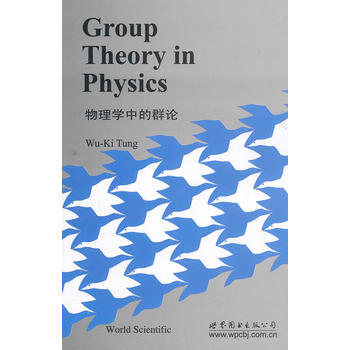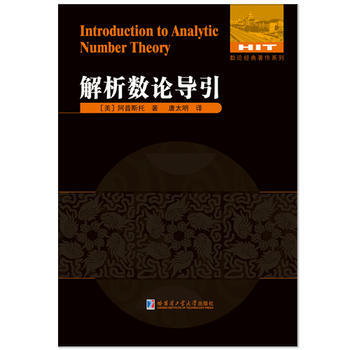

具体描述
基本信息
书名:物理学中的群论
:49.00元
作者:(美)吴基东
出版社:世界图书出版公司
出版日期:2011-01-01
ISBN:9787510029554
字数:
页码:
版次:1
装帧:平装
开本:24开
商品重量:0.440kg
编辑推荐
内容提要
group theory provides the natural mathematical language toformulate symmetry principles and to derive their consequences inmathematics and in physics. the 'special functions' of mathematicalphysics, which pervade mathematical analysis,classical physics, andquantum mechanics, invariably originate from underlying symmetriesof the problem although the traditional presentation of such topicsmay not expressly emphasize this universal feature. moderndevelopments in all branches of physics are putting more and moreemphasis on the role of symmetries of the underlying physicalsystems. thus the use of group theory has bee increasinglyimportant in recent years. however, the incorporation of grouptheory into the undergraduate or graduate physics curriculum ofmost universities has not kept up with this development. at best,this subject is offered as a special topic course, catering to arestricted class of students. symptomatic of this unfortunate gapis the lack of suitable textbooks on general group-theoreticalmethods in physics for all serious students of experimental andtheoretical physics at the beginning graduate and advancedundergraduate level. this book is written to meet precisely thisneed.
there already exist, of course, many books on group theory andits applications in physics. foremost among these are the oldclassics by weyl, wigner, and van der waerden. for applications toatomic and molecular physics, and to crystal lattices in solidstate and chemical physics, there are many elementary textbooksemphasizing point groups, space groups, and the rotation group.reflecting the important role played by group theory in modernelementary particle theory, many current books expound on thetheory of lie groups and lie algebras with emphasis suitable forhigh energy theoretical physics. finally, there are several usefulgeneral texts on group theory featuring prehensiveness andmathematical rigor written for the more mathematically orientedaudience. experience indicates, however, that for most students, itis difficult to find a suitable modern introductory text which isboth general and readily understandable.
目录
preface
chapter 1 introduction
1.1 particle on a one-dimensional lattice
1.2 representations of the discrete translation operators
1.3 physical consequences of translational symmetry
1.4 the representation functions and fourier analysis
1.5 symmetry groups of physics
chapter 2 basic group theory
2.1 basic definitions and simple examples
2.2 further examples, subgroups
2.3 the rearrangement lemma and the symmetric (permutation)group
2.4 classes and invariant subgroups
2.5 cosets and factor (quotient) groups
2.6 homomorphisms
2.7 direct products
problems
chapter 3 group representations
3.1 representations
3.2 irreducible, inequivalent representations
3.3 unitary representations
3.4 schur's lemmas
3.5 orthonormality and pleteness relations of irreduciblerepresentation matrices
3.6 orthonormality and pleteness relations of irreduciblecharacters
3.7 the regular representation
3.8 direct product representations, clebsch-gordancoefficients
problems
chapter 4 general properties of irreducible vectors andoperators
4.1 irreducible basis vectors
4.2 the reduction of vectors--projection operators for irreducibleponents
4.3 irreducible operators and the wigner-eckart theorem
problems
chapter 5 representations of the symmetric groups
5.1 one-dimensional representations
5.2 partitions and young diagrams
5.3 symmetrizers and anti-symmetrizers of young tableaux
5.4 irreducible representations of sn
5.5 symmetry classes of tensors
problems
chapter 6 one-dimensional continuous groups
6.1 the rotation group so(2)
6.2 the generator of so(2)
6.3 irreducible representations of so(2)
6.4 invariant integration measure, orthonormality and pletenessrelations
6.5 multi-valued representations
6.6 continuous translational group in one dimension
6.7 conjugate basis vectors
problems
chapter 7 rotations in three-dimensional space--the groupso(3)
7.1 description of the group so(3)
7.1.1 the angle-and-axis parameterization
7.1.2 the euler angles
7.2 one parameter subgroups, generators, and the lie algebra
7.3 irreducible representations of the so(3) lie algebra
7.4 properties of the rotational matrices dj(a, fl, 7)
7.5 application to particle in a central potential
7.5.1 characterization of states
7.5.2 asymptotic plane wave states
7.5.3 partial wave deposition
7.5.4 summary
7.6 transformation properties of wave functions andoperators
7.7 direct product representations and their reduction
7.8 irreducible tensors and the wigner-eckart theorem
problems
chapter 8 the group su(2) and more about so(3)
8.1 the relationship between so(3) and su(2)
8.2 invariant integration
8.3 Orthonormality and pleteness relations of dj
8.4 projection operators and their physical applications
8.4.1 single particle state with spill
8.4.2 two particle states with spin
8.4.3 partial wave expansion for two particle scattering withspin
8.5 differential equations satisfied by the dj-functions
8.6 group theoretical interpretation of spherical harmonics
8.6.1 transformation under rotation
8.6.2 addition theorem
8.6.3 deposition of products of yim with the samearguments
8.6.4 recursion formulas
8.6.5 symmetry in m
8.6.6 Orthonormality and pleteness
8.6.7 summary remarks
8.7 multipole radiation of the electromagic field
problems
chapter 9 euclidean groups in two- and three-dimensionalspace
9.1 the euclidean group in two-dimensional space e2
9.2 unitary irreducible representations of e2--theangular-momentum basis
9.3 the induced representation method and the plane-wavebasis
9.4 differential equations, recursion formulas,and additiontheorem of the bessel function
9.5 group contraction--so(3) and e2
9.6 the euclidean group in three dimensions: e3
9.7 unitary irreducible representations of e3 by the inducedrepresentation method
9.8 angular momentum basis and the spherical bessel function
problems
chapter 10 the lorentz and poincarie groups, and space-timesymmetries
10.1 the lorentz and poincare groups
10.1.1 homogeneous lorentz transformations
10.1.2 the proper lorentz group
10.1.3 deposition of lorentz transformations
10.1.4 relation of the proper lorentz group to sl(2)
10.1.5 four-dimensional translations and the poincare group
10.2 generators and the lie algeebra
10.3 irreducible representations of the proper lorentz group
10.3.1 equivalence of the lie algebra to su(2) x su(2)
10.3.2 finite dimensional representations
10.3.3 unitary representations
10.4 unitary irreducible representations of the poincaregroup
10.4.1 null vector case (pu= 0)
10.4.2 time-like vector case (c1>3 0)
10.4.3 the second casimir operator
10.4.4 light-like case (c1 = 0)
10.4.5 space-like case (c1<0)
10.4.6 covariant normalization of basis states and integrationmeasure
10.5 relation between representations of the lorentz and poincaregroups--relativistic wave functions, fields, and waveequations
10.5.1 wave functions and field operators
10.5.2 relativistic wave equations and the plane waveexpansion
10.5.3 the lorentz-poincare connection
10.5.4 'deriving' relativistic wave equations
problems
chapter 11 space inversion invariance
11.1 space inversion in two-dimensional euclidean space
11.1.1 the group 0(2)
11.1.2 irreducible representations of 0(2)
11.1.3 the extended euclidean group e2 and its irreduciblerepresentations
11.2 space inversion in three-dimensional euclidean space
11.2.1 the group 0(3) and its irreducible representations
11.2.2 the extended euclidean group e3 and its irreduciblerepresentations
11.3 space inversion in four-dimensional minkowski space
11.3.1 the plete lorentz group and its irreduciblerepresentations
11.3.2 the extended poincare group and its irreduciblerepresentations
11.4 general physical consequences of space inversion
11.4.1 eigenstates of angular momentum and parity
11.4.2 scattering amplitudes and electromagic multipoletransitions
problems
chapter 12 time reversal invariance
12.1 preliminary discussion
12.2 time reversal invariance in classical physics
12.3 problems with linear realization of timereversaltransformation
12.4 the anti-unitary time reversal operator
12.5 irreducible representations of the full poincare group in thetime-like case
12.6 irreducible representations in the light-like case (c1 = c2 =n0)
12.7 physical consequences of time reversal invariance
12.7.1 time reversal and angular momentum eigenstates
12.7.2 time-reversal symmetry of transition amplitudes
12.7.3 time reversal invariance and perturbation amplitudes
problems
chapter 13 finite-dimensional representations of the classicalgroups
13.1 gl(m): fundamental representations and the associated vectorspaces
13.2 tensors in v x v, contraction, and gl(m)transformations
13.3 irreducible representations of gl(m) on thespace of generaltensors
13.4 irreducible representations of other classical lineargroups
13.4.1 unitary groups u(m) and u(m , m_)
13.4.2 special linear groups sl(m) and special unitary groupssu(m , m_)
13.4.3 the real orthogonal group o(m ,m_; r) and the special realorthogonal group so(m , m_; r)
13.5 concluding remarks
problems
appendix i notations and symbols
i.1 summation convention
i.2 vectors and vector indices
i.3 matrix indices
appendix ii summary of linear vector spaces
ii.1 linear vector space
ii.2 linear transformations (operators) on vector spaces
ii.3 matrix representation of linear operators
ii.4 dual space, adjoint operators
ii.5 inner (scalar) product and inner product space
ii.6 linear transformations (operators) on inner productspaces
appendix iii group algebra and the reduction of regularrepresentation
iii. 1 group algebra
1ii.2 left ideals, projection operators
iii.3 idempotents
iii.4 plete reduction of the regular representation
appendix iv supplements to the theory of symmetric groups sn
appendix v clebsch-gordan coefficients and sphericalharmonics
appendix vi rotational and lorentz spinors
appendix vii unitary representations of the proper lorentzgroup
appendix viii anti-linear operators
references and bibliography
index
作者介绍
文摘
序言
用户评价
这本书在处理高级专题时的组织结构,简直可以作为范本。我特别关注了它在规范场论和量子场论中应用群论的部分。通常,这部分内容在其他教材中往往是点到为止或者过于简略,但在这里,作者花了相当的篇幅来系统阐述从李群到李代数,再到杨-米尔斯理论的构建过程。书中对根系和权图的讲解异常详尽,配有大量的例子,展示了如何利用这些工具来确定粒子的分类和相互作用的结构。我印象最深的是,它清晰地区分了紧致群和非紧致群在物理模型中的不同角色,并辅以SU(2)和SU(3)的经典案例进行对比。这种对比不仅加深了对数学概念的理解,更重要的是,它帮助读者理解了为什么某些群结构自然地会出现在描述基本相互作用的理论中。这本书的价值在于,它没有把群论视为一种外加的工具箱,而是将其内化为物理理论自身逻辑的必然结果。读完相关章节,我对标准模型的对称性破缺有了更清晰、更结构化的认识,仿佛拨开了长期笼罩在心头的迷雾。
评分从排版的角度来看,这本书的质量非常高,纸张的触感和印刷的清晰度都体现了出版方对学术著作的尊重。但更重要的是,它在内容编排上体现出的“教学智慧”。书的结构设计仿佛在精心策划一场循序渐进的智力攀登。它从最基础的群定义开始,稳步上升到表示论,然后引入到物理系统的具体应用,比如哈密顿量的对称性分析。特别值得称赞的是,作者在每个章节的末尾都设置了“拓展阅读”和“历史背景”的简短注释,这些小小的插曲极大地丰富了阅读体验,让我了解到某个定理背后的科学史轶事,以及不同学派对同一问题的不同侧重。这种“润物细无声”的教学方法,使得即使是那些比较枯燥的数学证明,也因为有了其历史和物理的背景支撑,而变得生动起来。这本书读完后,我感觉自己不仅掌握了一套强大的分析工具,更重要的是,我以一种全新的、更具洞察力的方式重新审视了整个理论物理学的框架。它不仅仅是一本工具书,更是一部关于物理思维的哲学导论。
评分不得不提的是,这本书的数学严谨性是毋庸置疑的,但它处理抽象概念的方式却充满了艺术感。对我而言,最难啃的章节往往是那些关于纤维丛和联络的介绍,但这本书通过引入几何化的观点,大大降低了理解的门槛。作者似乎很擅长将高深的拓扑概念“可视化”。例如,在解释贝里相位时,它不仅仅是给出了一个数学表达式,而是用了一个非常巧妙的类比,将量子态随参数变化的轨迹映射到一个几何空间上的路径积分,使得那个抽象的相位因子获得了鲜活的几何意义。这种叙事策略对于那些既有扎实的物理基础又渴望深入理解数学几何根源的读者来说,是极大的福音。此外,书中的习题设计也非常巧妙,它们不是那种简单的计算练习,而是引导你探索群论在更前沿课题(如拓扑绝缘体或弦论的某些基础概念)中潜力的思考题。完成这些习题的过程,与其说是检验学习效果,不如说是一次自主的科研探索。
评分我得说,这本书的叙事风格非常独特,它不像传统教材那样冷冰冰地堆砌公式,反而带着一种近乎哲学的思辨色彩。在探讨庞加莱群和洛伦兹群的部分,作者巧妙地将狭义相对论的基本原理与群论的结构联系起来,这种跨越学科边界的洞察力令人耳目一新。我尤其欣赏作者在论证过程中,总能保持一种“物理优先”的姿态。很多数学书籍在处理群论时,往往会把物理背景弱化为纯粹的代数练习,但这本书始终将物理图像牢牢地锚定在数学的抽象之上。比如,它对角动量算符的阶梯算符方法的引入,并不是孤立地讲解代数技巧,而是紧密结合了球谐函数和角动量量子化的具体物理场景。这种处理方式极大地提升了阅读的乐趣和理解的深度。我发现,当我对某个物理现象感到困惑时,翻阅这本书相关的章节,往往能找到一个全新的、更深刻的数学视角来解释它。这本书不适合快速浏览,它要求读者慢下来,去品味每一个定理背后的物理意义,是一种需要投入精力的“慢读”体验。
评分这本《物理学中的群论》的深度和广度简直让人惊叹,尤其是对于那些试图在理论物理领域扎根的学者而言,它绝对是一本不可多得的宝藏。作者在开篇部分,并没有急于抛出复杂的数学结构,而是用非常细腻的笔触勾勒出群论在对称性概念中的核心地位。我个人最欣赏的是它在讲解基础概念时所展现出的那种严谨与直观的完美平衡。比如,当我们讨论到晶体结构或粒子物理中的宇称守恒时,书中的解释就显得格外清晰。它不仅仅是简单地罗列定义和定理,而是深入剖析了这些数学工具是如何“解决”物理问题的。书中对表示论的阐述更是下了苦功,从酉表示的性质到不可约表示的构建,每一步都辅以详实的物理实例,让人仿佛能亲眼看到那些抽象的变换如何在实际的量子态之间作用。阅读过程中,我感觉自己不再是简单地记忆公式,而是在构建一个完整的、内在自洽的物理图景。尽管内容密度极高,但排版和图示的精心设计有效缓解了阅读疲劳,使得即便是面对如薛定谔方程在特定群作用下的不变性这类复杂话题时,也能保持清晰的思路。它更像是一位经验丰富的导师,耐心引导你穿越数学的迷雾,直抵物理的本质。
相关图书
本站所有内容均为互联网搜索引擎提供的公开搜索信息,本站不存储任何数据与内容,任何内容与数据均与本站无关,如有需要请联系相关搜索引擎包括但不限于百度,google,bing,sogou 等
© 2025 book.coffeedeals.club All Rights Reserved. 静流书站 版权所有




















